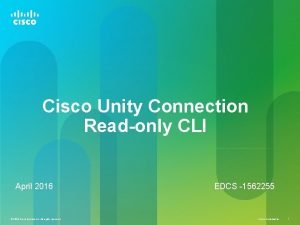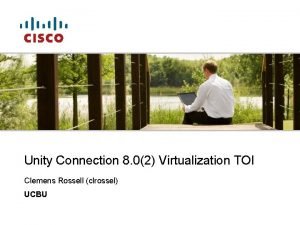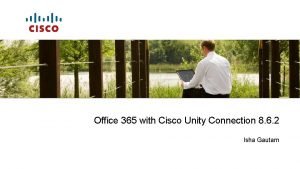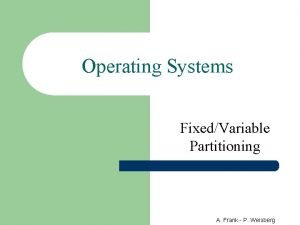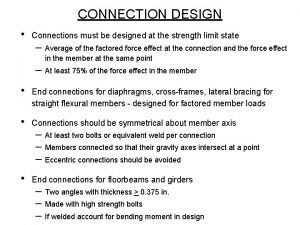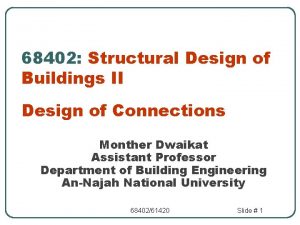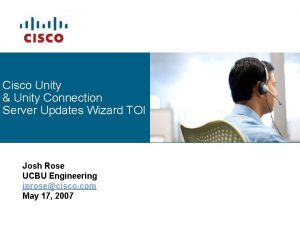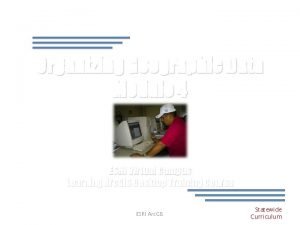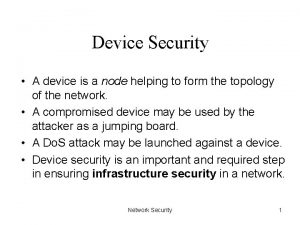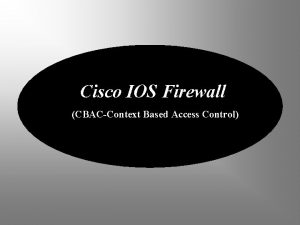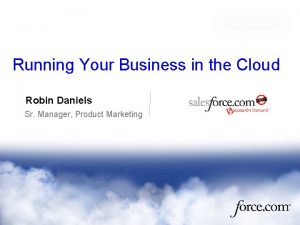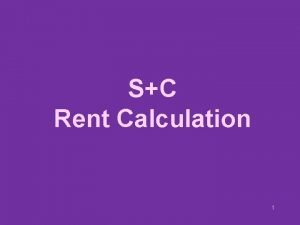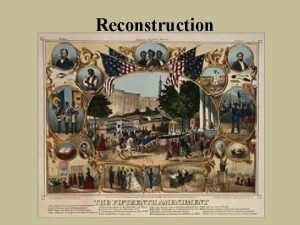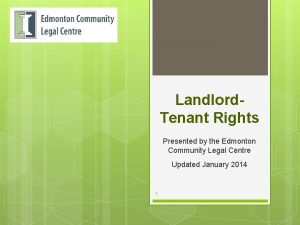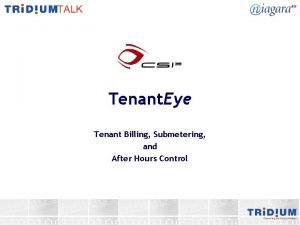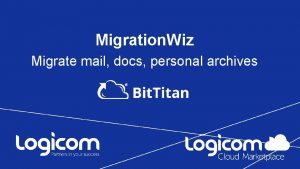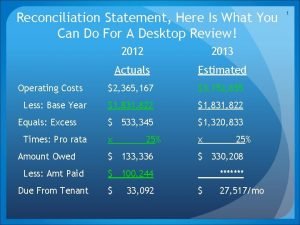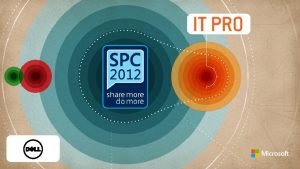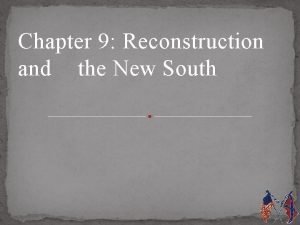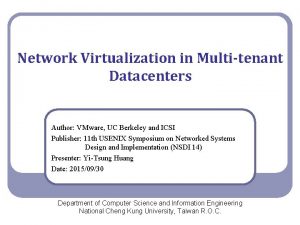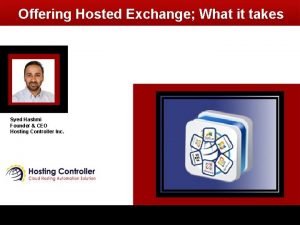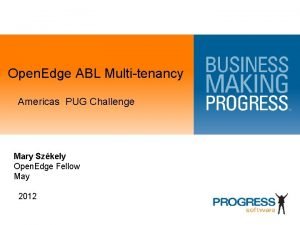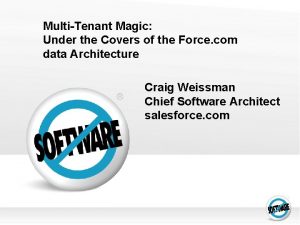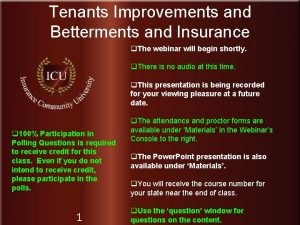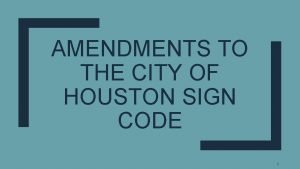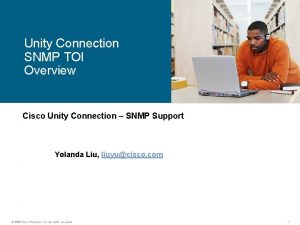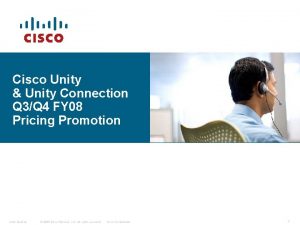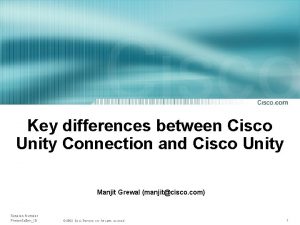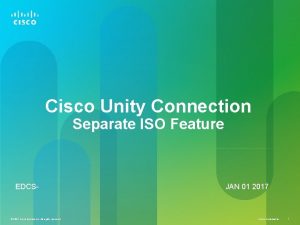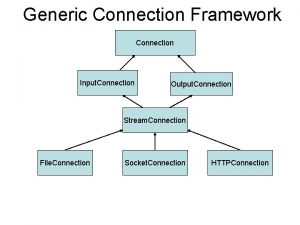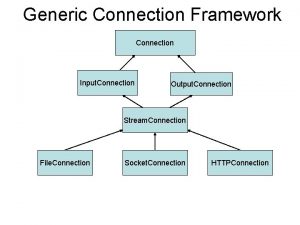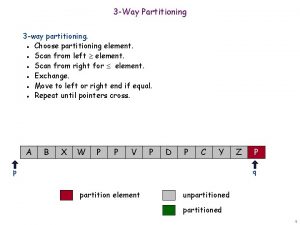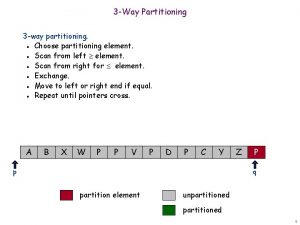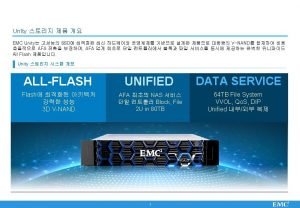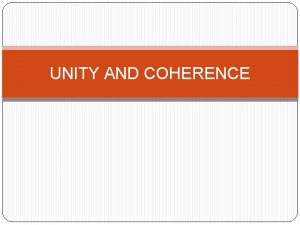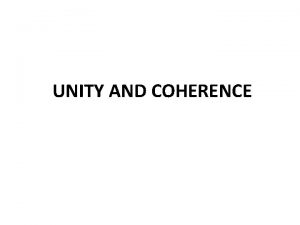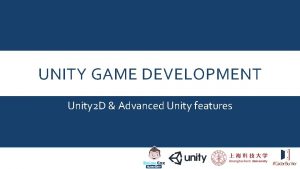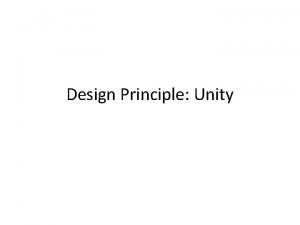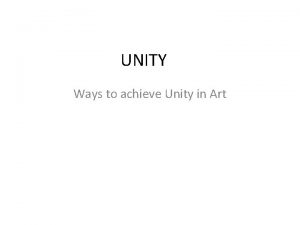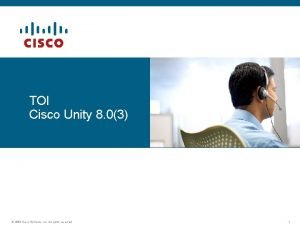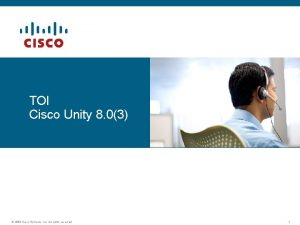Tenant Partitioning feature for Cisco Unity Connection 10









































































- Slides: 73

Tenant Partitioning feature for Cisco Unity Connection 10. 0 TOI for Tenant Partitioning feature for Cisco Unity Connection EDCS-1279930 Mon DD, YYYY © 2012 Cisco and/or its affiliates. All rights reserved. Cisco Confidential 1

Notice The information in this presentation is provided under Non-Disclosure agreement and should be treated as Cisco Confidential. Under no circumstances is this information to be shared further without the express consent of Cisco. Any roadmap item is subject to change at the sole discretion of Cisco, and Cisco will have no liability for delay in the delivery or failure to deliver any of the products or features set forth in this document. © 2012 Cisco and/or its affiliates. All rights reserved. Cisco Confidential 2

• Tenant Partitioning Feature for Cisco Unity Connection Overview • Supported Topologies • Working with Tenant Partitioning Feature • Migration • Backup, Restore and Upgrade • Troubleshooting • References © 2012 Cisco and/or its affiliates. All rights reserved. Cisco Confidential 3

© 2012 Cisco and/or its affiliates. All rights reserved. Cisco Confidential 4

Tenant partitioned Cisco Unity Connection can be thought of as a cloud based voice mail solution where service providers can provide voice mail service to multiple SMBs on single installation of CUC. A Tenant is a logical grouping of objects within the Unity Connection appliance that together make an independent tenant (customer) hosted on the server. Unity Connection will let you have more than one tenant on a single installation. These tenants will exist as islands within the server and would have no knowledge of each other. Tenant Partitioning is the Unity Connection feature that enables the appliance to host more than one tenant. © 2012 Cisco and/or its affiliates. All rights reserved. Cisco Confidential 5

• This feature offers an effective voice messaging solution targeting the SMBs having up to 100 users (50 Users on a standalone Unity Connection Server). • Multiple tenants, each corresponding to an SMB, can be configured on a single CUC installation. • Maps many types of objects like Partition, Phone System, COS and Schedule Set to a tenant. • Introduces corporate email address as Alias to enable alias uniqueness across tenants. • Separate CUC SMTP domain for each tenant. • Currently provides voicemail only solution; unified messaging and LDAP integrations will be supported in later releases. • Administrator would manage the tenant objects using the designated provisioning tool. © 2012 Cisco and/or its affiliates. All rights reserved. Cisco Confidential 6

One tenant will have only one Partition, one Search Space, one Phone System but could have multiple User Templates and other objects. Partition Users User Templates Search Space Members Routing Rules Distribution Lists Routing Rule Conditions System CH Directory Handlers Interview Handlers PG Servers Port Groups Tenant PG Codecs Phone System Ports PS Associations Schedule Set Members Schedules COS Schedule Details Operator User © 2012 Cisco and/or its affiliates. All rights reserved. Cisco Confidential 7

© 2012 Cisco and/or its affiliates. All rights reserved. Cisco Confidential 8

To login onto CUC Web Interfaces like Web Inbox, CPCA and VM REST, each user belonging to any tenant would use the corporate email address. Users will not have access to the SA webpage and it would not be used provision tenants. As an example for tenant Texoma, user john@texoma. com would login onto Web Inbox and CPCA as shown in the picture. © 2012 Cisco and/or its affiliates. All rights reserved. Cisco Confidential 9

• Different Virtual Platform Overlays allow creation of different number of tenants. OVAs that can be Used 20, 000 Users 10, 000 Users 5, 000 Users 1000 Users For information related to the system requirements, you can refer to the Supported Platform list Guide: http: //www. cisco. com/en/US/docs/voice_ip_comm/connection/9 x/supported_platforms/9 xcuc spl. html Note: Links to Supported Platform List guiders for 10. X guides will be updated later. © 2012 Cisco and/or its affiliates. All rights reserved. Cisco Confidential 10

© 2012 Cisco and/or its affiliates. All rights reserved. Cisco Confidential 11

Each Tenant will be assigned unique Phone System to identify inbound and outbound voice mail traffic. Also, • All inbound and outbound traffic related to a Tenant will be mapped to that particular phone system only. • Each tenant will have its own routing rules, Call handlers etc. to manage calls accordingly. © 2012 Cisco and/or its affiliates. All rights reserved. Cisco Confidential 12

© 2012 Cisco and/or its affiliates. All rights reserved. Cisco Confidential 13

© 2012 Cisco and/or its affiliates. All rights reserved. Cisco Confidential 14

How to provision a Tenant and get it working? Create Tenant © 2012 Cisco and/or its affiliates. All rights reserved. Create Port Group Create Ports Integrate with CUCM Create User for the tenant Record Greetings Call Pilot Number Cisco Confidential 15

Create Tenant © 2012 Cisco and/or its affiliates. All rights reserved. Create Port Group Create Ports Integrate with CUCM Create User for the tenant Record Greetings Call Pilot Number Cisco Confidential 16

For tenant provisioning, a new API has been introduced in CUC. Highlights about Tenant creation 1. Tenant creation is an atomic operation and all its associated objects are created by executing a single API request. 2. If operation fails at any point in time, the entire process will be rolled back. 3. More objects like COS, Schedule Sets etc. can be associated with the tenant later. © 2012 Cisco and/or its affiliates. All rights reserved. Cisco Confidential 17

To create a tenant, an HTTP POST request should be sent to the URI https: //<connection-server>/vmrest/tenants The request should contain values for the following fields: 1. Alias: Represents the alias of the tenant. 2. SMTPDomain: Represents the corporate SMTP Domain of the tenant. 3. Description [Optional]: Description of the tenant. 4. Mailbox. Store. Object. Id [Optional]: Object ID of the Mailbox Store. 5. Language [Optional]: Language of the tenant, and of the default objects created with the tenant. 5. Timezone [Optional]: Time zone of the tenant, and of the default objects created with the tenant. Note: For the optional parameters, if no value is specified then system default values will be used. © 2012 Cisco and/or its affiliates. All rights reserved. Cisco Confidential 18

Create Tenant © 2012 Cisco and/or its affiliates. All rights reserved. Create Port Group Create Ports Integrate with CUCM Create User for the tenant Record Greeting Call Pilot Number Cisco Confidential 19

To create a port group, an HTTP POST request should be sent to the URI https: //<connection-server>/vmrest/portgroups The request should contain values for the following fields: 1. Display. Name: Display name of the port group. 2. Media. Switch. Object. Id: Object Id of the phone system. 3. Media. Port. Group. Template. Object. ID: Object. Id of the template for the Port group. 4. Telephony. Integration. Method. Enum: Value “ 2” to create SIP port Group 5. Hostor. Ip. Address: Hostname or IP Address of the CUCM server. Note: Tenant Partitioning supports SIP integration only. © 2012 Cisco and/or its affiliates. All rights reserved. Cisco Confidential 20

Create Tenant © 2012 Cisco and/or its affiliates. All rights reserved. Create Port Group Create Ports Integrate with CUCM Create User for the tenant Record Greetings Call Pilot Number Cisco Confidential 21

To create a port, an HTTP POST request should be sent to the URI https: //<connection-server>/vmrest/ports The request should contain values for the following fields: 1. Media. Port. Group. Object. Id: The Object Id of the Media. Port. Group object to which this port would belong to. 2. Vms. Server. Object. Id: The Object Id of the of VMSServer to which this port would belong to. 3. Number. Of. Ports: Number of ports that you want to create. © 2012 Cisco and/or its affiliates. All rights reserved. Cisco Confidential 22

Create Tenant © 2012 Cisco and/or its affiliates. All rights reserved. Create Port Group Create Ports Integrate with CUCM Create User for tenant Record Greetings Call Pilot Number Cisco Confidential 23

Create SIP Security Profile Create SIP Profile Create Trunk to Unity Connection Create Route Group Create Route List NOTE: For detailed information, please visit the Cisco Unified Communications Manager SIP Integration Guide for Cisco Unity Connection http: //www. cisco. com/en/US/docs/voice_ip_comm/connection/9 x/integration/guide/cucm_sip/cucintcucmsip. html Create Route Pattern Create Voice Mail Pilot and Voice Mail Profile © 2012 Cisco and/or its affiliates. All rights reserved. Cisco Confidential 24

Create Tenant © 2012 Cisco and/or its affiliates. All rights reserved. Create Port Group Create Ports Integrate with CUCM Create User for the tenant Record Greetings Call Pilot Number Cisco Confidential 25

To create a user, an HTTP POST request should be sent to the URI https: //<connection-server>/vmrest/users? template. Alias=<Tenant. User. Template) User template specified in the URI should be the one that belongs to the tenant you are creating user for. The request should contain values for the following fields: 1. Alias: A unique text name for User. 2. Dtmf. Access. Id: The DTMF access id (i. e. , extension) of the user. © 2012 Cisco and/or its affiliates. All rights reserved. Cisco Confidential 26

Create Tenant © 2012 Cisco and/or its affiliates. All rights reserved. Create Port Group Create Ports Integrate with CUCM Create User for the tenant Record Greetings Call Pilot Number Cisco Confidential 27

To record a greeting follow this 3 -step process: 1. Create a temporary place-holder WAV file on CUC via POST operation on the URI https: //<connection-server>/vmrest/voicefiles 2. Use the temporary file name created in Step 1 to PUT the new audio. The HTTP content type is "audio/wav" and the payload content is the audio data. https: //<connection-server>/vmrest/voicefiles/<Temporary. File. Name> 3. Assign temporary audio WAV file to the target resource. Perform a POST operation on the following URI: https: //<connectionserver>/vmrest/handlers/callhandlers/<Tenant. Call. Handler. Object. Id>/greetings/Standard/greetingstr eamfiles/1033 © 2012 Cisco and/or its affiliates. All rights reserved. Cisco Confidential 28

Create Tenant Create Port Group Create Ports Integrate with CUCM Create User for the tenant Record Greetings Call Pilot Number Configuration is now complete. Dial the pilot number. You will hear the recorded opening greeting. Note: For detailed information about provisioning APIs, visit the following link: http: //docwiki. cisco. com/wiki/Cisco_Unity_Connection_Provisioning_Interface_%28 CUPI%29 _API © 2012 Cisco and/or its affiliates. All rights reserved. Cisco Confidential 29

© 2012 Cisco and/or its affiliates. All rights reserved. Cisco Confidential 30

• Consolidated Object Backup and Restore Application Suite (COBRAS) is a set of tools designed to allow administrator to migrate the data from one CUC to another. • COBRAS for Tenant Partitioning allows administrator to backup and restore tenant data and all the objects which are directly or indirectly associated with it. • COBRAS will support migration of following scenarios in Tenant Partitioning deployment: 1. Tenant migration from a Tenant Partitioned CUC to another Tenant Partitioned CUC. 2. Tenant migration from a Tenant Partitioned CUC to a Standalone CUC. 3. Data migration (Subscribers only) from a Standalone CUC to a Tenant Partitioned CUC. © 2012 Cisco and/or its affiliates. All rights reserved. Cisco Confidential 31

• Backup If CUC supports the Tenant Partitioning feature, then while taking backup COBRAS Export tool will provide option to select a tenant. This backup will export all the objects which are directly or indirectly mapped with the selected tenant. • COBRAS will create the backup files with the following naming convention 1. Unity. DBData_Backup_<Connectionserver>_<Tenant. Alias>_<year><month><day>_<hour>_<mi nute>_<second>. mdb 2. Unity. Message_Backup_<Connectionserver>_<Tenant. Alias>_<year><month><day>_<hour>_< minute>_<second>. mdb NOTE: For detailed information, please visit the following online help link for COBRAS support for Tenant Partitioning http: //www. ciscounitytools. com/Applications/General/COBRAS. html © 2012 Cisco and/or its affiliates. All rights reserved. Cisco Confidential 32

Diagram shows the dependency of all the objects backed up via the COBRAS Export tool. The objects on the left are prerequisites for backing up objects on the right. Menu Entry Call Handler/Call Handler Templates Greetings Directory Handler Transfer Rules Interview Handler Alternate Extension Notification Devices Partition Alternate Contact Number Phone System MWI User/User Templates Private Distribution List Tenant Search Spaces SMTP Proxy Public Distribution List Schedule Sets Authentication Rules Schedules Mailboxes COS Restriction Tables © 2012 Cisco and/or its affiliates. All rights reserved. Cisco Confidential 33

• For multi-tenant system, COBRAS import tool supports restore of selected objects which are different for each migration scenario. • The number of pages in COBRAS Import wizard is also different for each migration scenario. COBRAS Import wizard is divided into the following parts: 1. Select which backed up objects administrator want to restore. 2. Resolve conflicts restoring any of the objects which administrator selected during part 1. 3. Resolve link references for any objects that administrator choose to restore in part 1. NOTE: For detailed information, please visit the following online help link for COBRAS support for Tenant Partitioning http: //www. ciscounitytools. com/Applications/General/COBRAS. html © 2012 Cisco and/or its affiliates. All rights reserved. Cisco Confidential 34

Login to COBRAS Import Tool Select the Backup file to restore Login to COBRAS Export Tool Select the Tenant to take backup Start the Export Process Unity. Backupdta_Tenant 1_2013_08_96. mdb Select “Import backup in a multi-tenant system” Select Object to restore in CUC Resolve conflicts for the selected objects • Administrator wants to migrate the tenant specific data from a multi-tenant Unity Connection to another multi-tenant Unity Connection. • Prerequisites: Administrator has to create a Tenant in the target CUC as a prerequisite for restore process. This tenant should have the same Alias and Domain as that present in the backup file of the exported data. Resolve link references of the selected objects Start the Import Process © 2012 Cisco and/or its affiliates. All rights reserved. Cisco Confidential 35

Login to COBRAS Import Tool Select the Backup file to restore Login to COBRAS Export Tool Select the Tenant to take backup Start the Export Process Unity. Backupdta_Tenant 1_2013_08_96. mdb Select “Import backup in a standalone system” option Select Object to restore in CUC • Administrator wants to migrate the tenant specific data from a multi-tenant Unity Connection to Standalone Unity Connection. • Prerequisites: Administrator can either • create new partition, search space, phone system, COS, Subscriber templates, call handler templates in the target CUC to map the objects during Import process or • administrator can map the imported objects with the default system objects present in the target CUC. Resolve conflicts for the selected objects Resolve link references of the selected objects Start the Import Process © 2012 Cisco and/or its affiliates. All rights reserved. Cisco Confidential 36

Login to COBRAS Import Tool Select the Backup file to restore Login to COBRAS Export Tool Select the export options as per the backup requirement Start the Export Process Unity. Backupdta_2013_0 8_96. mdb Select “Tenant to restore” backup Select Subscribers to restore in CUC • Administrator of standalone Unity Connection exports the data and restores the same into multi-tenant Connection system. • Prerequisites: Administrator has to create a tenant in the target CUC with unique Tenant alias and SMTP domain. While restoring, administrator can only select subscribers except default users. Resolve conflicts for the Subscribers Resolve link references of the Subscribers Start the Import Process © 2012 Cisco and/or its affiliates. All rights reserved. Cisco Confidential 37

• For debugging the issue , you can refer the logs at the following path: Log Path: <Installation Directory>Logs • For any issues related to COBRAS, you can refer to the following online help http: //www. ciscounitytools. com/Applications/General/COBRAS. html © 2012 Cisco and/or its affiliates. All rights reserved. Cisco Confidential 38

© 2012 Cisco and/or its affiliates. All rights reserved. Cisco Confidential 39

• The Disaster recovery tool (DRS) installed with along Unity Connection is used for Backup and Restore. • The Backup and Restore procedure is the same and no changes have been made for Tenant Partitioning feature. • Tenants can be successfully backed up and restored. For any other information related to CUC DRS backup and restore, you can refer to the Backup and Restore Guide: http: //www. cisco. com/en/US/docs/voice_ip_comm/connection/9 x/drs_administration/guide/9 x cucdrsag. html Note: Links to Installation and Troubleshooting Guides for 10. X will be updated later © 2012 Cisco and/or its affiliates. All rights reserved. Cisco Confidential 40

• The upgrade process is responsible for the orderly upgrade of the system from one version to the next. • The upgrade process is same as before and no changes have been introduced with this feature. • Unity connection release with Tenant Partitioning feature can only be upgrade to higher version of Unity Connection release with Tenant Partitioning feature. • Tenant partitioning feature is supported from 10. 0. • Upgrade is supported from previous Unity Connection release • However, to use the Tenant Partitioning feature on a server upgraded to Unity Connection 10. 0 version, delete all the existing data from the system and then create tenants. © 2012 Cisco and/or its affiliates. All rights reserved. 10. 0 Cisco Confidential 41

For any other information related to CUC Upgrade, you can refer to the Upgrade Guide: http: //www. cisco. com/en/US/docs/voice_ip_comm/connection/9 x/upgrade/guide/9 xcucrugx. ht ml You can also take a look at the Troubleshooting Guide: http: //www. cisco. com/en/US/docs/voice_ip_comm/connection/9 x/troubleshooting/guide/9 xcuc tsgx. html Note: Links to Upgrade and Troubleshooting Guides for 10. X will be updated later. © 2012 Cisco and/or its affiliates. All rights reserved. Cisco Confidential 42

© 2012 Cisco and/or its affiliates. All rights reserved. Cisco Confidential 43

The installation process is same as before and no changes have been introduced with this feature. For any issues related to CUC installation, you can refer to the Installation Guide: http: //www. cisco. com/en/US/docs/voice_ip_comm/connection/9 x/installation/guide/9 xcucigx. html You can also take a look at the Troubleshooting Guide: http: //www. cisco. com/en/US/docs/voice_ip_comm/connection/9 x/troubleshooting/guide/9 xcu ctsgx. html Note: Links to Installation and Troubleshooting Guides for 10. X will be updated later. © 2012 Cisco and/or its affiliates. All rights reserved. Cisco Confidential 44

For details on how to view diagnostic traces, you can refer the guide below: http: //www. cisco. com/en/US/docs/voice_ip_comm/connection/9 x/troubleshooting/guide/9 xcuc tsg 010. html © 2012 Cisco and/or its affiliates. All rights reserved. Cisco Confidential 45

Problem Statement: Tenant creation API fails on a freshly installed system, or a system without any tenants Action Required: 1. Check that Unity connection system does not have users of any partition other than a tenant partition; it should only have default users. To do this, you can run the following HTTP GET request: https: //<connection-server>/vmrest/users • Undeliverablemessagesmailbox • Operator © 2012 Cisco and/or its affiliates. All rights reserved. Cisco Confidential 46

2. When we try to create Tenant in a connection system having users of any other partition, error will occur as : “Invalid parameter. Parameter = [Non-Tenant users exists on Unity Connection. Cannot proceed with Tenant creation. ], Value = [tbl_user]” © 2012 Cisco and/or its affiliates. All rights reserved. Cisco Confidential 47

Problem Statement: You hear Opening Greeting on dialing the pilot number instead of being asked for the PIN number. Cause: This would happen when Opening Greeting routing rule is above the Attempt Sign-in routing rule for the tenant in the order of routing rules. © 2012 Cisco and/or its affiliates. All rights reserved. Cisco Confidential 48

Action Required: 1. Open Port Status Monitor and then dial the pilot number. 2. On Port Status Monitor, you would see that the call is going directly to the Opening Greeting as shown below: © 2012 Cisco and/or its affiliates. All rights reserved. Cisco Confidential 49

3. To check this, you can get the list of routing rules for the tenant by sending a GET request to the URI and check the value for Rule Index field: https: //<connectionserver>/vmrest/routingrules? query=(Search. Space. Object. Id%20 is%20<Tenant. Search. Space. Object. Id> To correct this, see the CUPI APIs documentation for Routing Rules API. http: //docwiki. cisco. com/wiki/Cisco_Unity_Connection_Provisioning_Interface_%28 CUPI%29_API © 2012 Cisco and/or its affiliates. All rights reserved. Cisco Confidential 50

Problem Statement: Users from one tenant are able to send messages to users from other tenants. Cause: This problem may occur when the Tenant’s Search Space contains partition(s) belonging to other tenants. Action Required: Check the tenant’s search space as To find out the Search Space and Partition associated with a tenant, do the following: © 2012 Cisco and/or its affiliates. All rights reserved. Cisco Confidential 51

1. Run an HTTP GET request on the URI below to get Search Space Object Id for the tenant: https: //<connectionserver>/vmrest/searchspacesmembers? query=(Partition. Object. Id%20 is%20<Tenant. Partition. Obje ct. Id>) 2. Run an HTTP GET request on the URI below to get the object id for partitions belonging to the tenant’s search space: https: //<connectionserver>/vmrest/searchspacesmembers? query=(Search. Space. Object. Id%20 is%20<Tenant. Search. Spac e. Object. Id) © 2012 Cisco and/or its affiliates. All rights reserved. Cisco Confidential 52

For example, Texoma tenant’s search space contains the partitions: i. Texoma_Partition_1 (belongs to tenant Texoma) ii. Donald_Partition_1 (belongs to tenant Donald) Users belonging to tenant Texoma will be able to send messages to users belonging to tenant Donald. You can correct this by changing the association. © 2012 Cisco and/or its affiliates. All rights reserved. Cisco Confidential 53

Problem Statement: You get option to select users from other partitions in directory results. Action Required: 1. Check Search Scope for the directory handler that belongs to the tenant. To do this, you can run the following HTTP GET request: https: //<connectionserver>/vmrest/handlers/directoryhandlers? query=(Partition. Object. Id%20 is%20<Tenant. Partition. Obje ct. Id) If the value of Search. Scope field is set to zero then it means that the Search Scope is set to Entire Server. Set the search scope to appropriate value to resolve the issue. © 2012 Cisco and/or its affiliates. All rights reserved. Cisco Confidential 54

2. Enable Micro Traces for General Method returns and Parameter values(01), Data access(02), Named property access(03) level Conv. Sub logs and Named props access(11), CDL Access(12), MIU Access(13) and Search Space(04) level CDE logs from Cisco Unity Connection Serviceability. For all the aliases that you hear over the call there will be an entry in diag_ Cu. Cs. Mgr_*. uc with the phone system attached to the users. Below is an extract for a user with the alias john@tenant. com: © 2012 Cisco and/or its affiliates. All rights reserved. Cisco Confidential 55

3. Search space can contain multiple partitions. To check if there are multiple partitions in search space, you can run the following HTTP GET request: To GET the search space: https: //<connection-server>/vmrest/searchspaces/<searchspaceobjectid>/searchspacemembers? query=(Partition. Object. Id%20 is%20<Tenant. Partition. Object. Id> From the above URI search space object id of a tenant will be obtained and it can be used to find the associated partitions with the URI below: To GET the search space: https: //<connection-server>/vmrest/searchspaces/<searchspaceobjectid>/searchspacemembers? query=(Search. Space. Object. Id%20 is%20<Search. Space. Object. Id > © 2012 Cisco and/or its affiliates. All rights reserved. Cisco Confidential 56

4. Check if the search space selected in Search scope of directory handler belongs to the same tenant or not. To do this run the following HTTP GET request: https: //<connection-server>/vmrest/handlers/directoryhandlers/<directoryhandler-objectid> Check the search scope object id, it should be same as that of the tenant. © 2012 Cisco and/or its affiliates. All rights reserved. Cisco Confidential 57

Problem Statement: On trying to delete a tenant, the error message “COS is referenced by at least one user or user template. ” is returned. This case is applicable for other objects associated with the tenant also. Cause: This issue may occur when objects mapped to a tenant like COS is associated with users belonging to other tenants. © 2012 Cisco and/or its affiliates. All rights reserved. Cisco Confidential 58

Action Required: To investigate this: 1. Get Object. Ids of the COS objects associated with the tenant using the URI: https: //<connection-server>/vmrest/tenants/<Tenant. Object. Id>/coses The following steps need to be repeated for all the resultant COS Object. Ids. 2. Get the list of user templates associated with the COS Object Id using the URI: https: //<connectionserver/vmrest/usertemplates? query=(Cos. Object. Id%20 is%20<Cos. Object. Id>) © 2012 Cisco and/or its affiliates. All rights reserved. Cisco Confidential 59

Here, replace <Cos. Object. Id> with the COS Object Id that belongs to the tenant. Now, to get the list of user templates that belongs to the tenant, use the URI below: https: //<connectionserver>/vmrest/usertemplates? query=(Cos. Object. Id%20 is%20<Cos. Object. Id>%26 Partition. Obje ct. Id%20 is%20<Partition. Object. Id) Comparing results of the GET operations would provide list of user templates that are associated with the Tenant’s COS but are not a part of Tenant’s partition. You can correct this by changing the COS association for these user templates. © 2012 Cisco and/or its affiliates. All rights reserved. Cisco Confidential 60

3. Get the list of users associated with the COS Object Id using the URI: https: //<connection-server>/vmrest/users? query=(Cos. Object. Id%20 is%20<Cos. Object. Id>) Here, replace <Cos. Object. Id> with the COS Object Id that belongs to the tenant. Now to get the list of users that belongs to the tenant, use the URI below : https: //<connectionserver>/vmrest/users? query=(Cos. Object. Id%20 is%20<Cos. Object. Id>%26 Partition. Object. Id%20 is%20<Partition. Object. Id) Comparing results of the GET operations would provide list of users that are associated with the Tenant’s COS but are not a part of Tenant’s partition. You can correct this by changing the COS association for these users. © 2012 Cisco and/or its affiliates. All rights reserved. Cisco Confidential 61

• 2 xx : Success Response. • 3 xx : Redirection of Request. • 4 xx : Client Error. • 5 xx : Server Error. © 2012 Cisco and/or its affiliates. All rights reserved. Cisco Confidential 62

Problem Statement: You hear the Fast Busy tone on dialing the pilot number. This tone is played in the following two cases: 1. Ports require reset 2. Ports are busy or locked © 2012 Cisco and/or its affiliates. All rights reserved. Cisco Confidential 63

Action Required: 1. Check if any port require a reset. You can check this on CUCA on the Port Groups page or using the Port group API. If for any Port Group, value for Needs Reset field is Yes/ True, then reset the Port Group. 2. To investigate if ports are busy: • Check if ports are busy • number of incoming calls is significantly high in peak hours • or number of incoming calls is high all the time Then based on tenant’s requirement there might be a need to additional ports. © 2012 Cisco and/or its affiliates. All rights reserved. Cisco Confidential 64

• Check CUC phone system: ports in Use Counter on RTMT to see if ports are busy. © 2012 Cisco and/or its affiliates. All rights reserved. Cisco Confidential 65

• The ports may be marked busy even if the ports are locked. To verify the same check on RTMT if the port frees up after a call ends and that it also answers other incoming calls. • You can also check the counter CUC phone system: Ports locked to check for any locked ports. Also, ports can be reset to resolve the port locking up. Ports locked counter in RTMT can be checked in the CUC Phone System counter. © 2012 Cisco and/or its affiliates. All rights reserved. Cisco Confidential 66

• RTMT log for Port locked and Port in use : © 2012 Cisco and/or its affiliates. All rights reserved. Cisco Confidential 67

Problem Statement: You hear the message “The system is temporarily unable to complete your call” on dialing the pilot number. Action Required: 1. This issue can occur when CUC does not have appropriate routing rules to process the call. To check this, enable Threads(11) and Ports(13) level Micro Traces for Arbiter on Cisco Unity Connection Serviceability and check the diag_Cu. Cs. Mgr_*. uc log file for the following: ‘Failed to find routing rule=Texoma_Phone. System_1’ Here, Texoma_Phone. System_1 is name of the phone system under consideration. © 2012 Cisco and/or its affiliates. All rights reserved. Cisco Confidential 68

Incase, no routing rules exist for the tenant then you can add them using the POST operation on the Routing Rules API. • Direct rules handle calls from users and unidentified callers that are dialed directly to Connection. • Forwarded rules handle calls that are forwarded to Connection from either a user extension or from an extension that is not associated with a user account You may also use the Port Status monitor to see the type of the call. If Port Status Monitor shows that the call doesn’t contain a Redirecting Id and value for the Reason field is Direct then Direct Routing Rule will be reached. See the screenshots below: © 2012 Cisco and/or its affiliates. All rights reserved. Cisco Confidential 69

3. Also, if Routing Rule Condition has been removed or is missing from a Routing Rule on CUC then Routing Rules that come later in the order, will never be reached. Example: Suppose, there are three routing rules and Routing Rule Condition does not exist for the second one then the third routing rule in the sequence will never be reached. To check if this is the case or to investigate the issue: i. ii. Check if Tenant’s phone system is added as a Routing Rule Condition in the Routing Rules for that tenant. Enable the Micro Traces for Routing Rules and Arbiter on Cisco Unity Connection Serviceability and check the logs for any errors or issues. © 2012 Cisco and/or its affiliates. All rights reserved. Cisco Confidential 70

iii. Check the phone system configuration like phone system, port groups, Ports and SIP Security Profile CUC. You can check the following: a) Verify that the port number specified in SIP Trunk profile on CUCM and the Port Group on CUC are same. b) Verify that SIP Trunk Security Profile on CUCM has the correct incoming port number. c) Verify the CUCM IP Address or Hostname specified in Port Group on CUC. © 2012 Cisco and/or its affiliates. All rights reserved. Cisco Confidential 71

© 2012 Cisco and/or its affiliates. All rights reserved. Cisco Confidential 72

Thank you. © 2012 Cisco and/or its affiliates. All rights reserved. Cisco Confidential 73
 Cisco unity connection administration
Cisco unity connection administration Cisco unity connection shared mailbox
Cisco unity connection shared mailbox Cisco unity connection ova
Cisco unity connection ova Unity connection office 365 troubleshooting
Unity connection office 365 troubleshooting Variable partition in os
Variable partition in os Slip critical connection vs bearing connection
Slip critical connection vs bearing connection Slip critical connection vs bearing connection
Slip critical connection vs bearing connection Slip critical connection vs bearing connection
Slip critical connection vs bearing connection Text to self examples
Text to self examples Unity connection to the update server failed
Unity connection to the update server failed Unity opus
Unity opus Isolated feature combined feature effects
Isolated feature combined feature effects Feature dataset vs feature class
Feature dataset vs feature class Unity rest api
Unity rest api Cisco ios resilient configuration feature
Cisco ios resilient configuration feature Cisco cbac
Cisco cbac Verdaderamente multi-tenant
Verdaderamente multi-tenant Tenant farmer's wife, alabama
Tenant farmer's wife, alabama Robinhood multi-tenant model
Robinhood multi-tenant model Tenant rent calculation worksheet
Tenant rent calculation worksheet Compare and contrast sharecropping and tenant farming
Compare and contrast sharecropping and tenant farming Rtdrs eviction representation
Rtdrs eviction representation Automatic tenant billing
Automatic tenant billing Enterprise vault migration to office 365 bittitan
Enterprise vault migration to office 365 bittitan Garden soxx
Garden soxx Tenant reconciliation statement
Tenant reconciliation statement Montana landlord tenant laws
Montana landlord tenant laws Tenant translate
Tenant translate In chapter 9 what do the tenant farmers
In chapter 9 what do the tenant farmers Sharecropping and tenant farming venn diagram
Sharecropping and tenant farming venn diagram Flex property management
Flex property management Carpetbaggers cartoon
Carpetbaggers cartoon Vmware multi tenant architecture
Vmware multi tenant architecture Exchange multi tenant control panel
Exchange multi tenant control panel Openedge multi-tenant cloud
Openedge multi-tenant cloud Tenant magic
Tenant magic Improvements & betterments
Improvements & betterments Apush sharecropping
Apush sharecropping Sharecropping and tenant farming venn diagram
Sharecropping and tenant farming venn diagram Multi tenant signs houston
Multi tenant signs houston Missouri tenant rights
Missouri tenant rights Nebraska minimum housing codes
Nebraska minimum housing codes Densitet vatten
Densitet vatten Elektronik för barn
Elektronik för barn Kung som dog 1611
Kung som dog 1611 Tack för att ni har lyssnat
Tack för att ni har lyssnat Smärtskolan kunskap för livet
Smärtskolan kunskap för livet Mall för referat
Mall för referat Fimbrietratt
Fimbrietratt Trög för kemist
Trög för kemist Karttecken tät skog
Karttecken tät skog Mindre än tecken
Mindre än tecken Autokratiskt ledarskap
Autokratiskt ledarskap Toppslätskivling dos
Toppslätskivling dos Underlag för särskild löneskatt på pensionskostnader
Underlag för särskild löneskatt på pensionskostnader Borra hål för knoppar
Borra hål för knoppar Bris för vuxna
Bris för vuxna Bra mat för unga idrottare
Bra mat för unga idrottare Etik och ledarskap etisk kod för chefer
Etik och ledarskap etisk kod för chefer Publik sektor
Publik sektor Teckenspråk minoritetsspråk argument
Teckenspråk minoritetsspråk argument Humanitr
Humanitr Datorkunskap för nybörjare
Datorkunskap för nybörjare Kontinuitetshantering
Kontinuitetshantering Returpilarna
Returpilarna Steg för steg rita
Steg för steg rita Ministerstyre för och nackdelar
Ministerstyre för och nackdelar Redogör för vad psykologi är
Redogör för vad psykologi är Lek med former i förskolan
Lek med former i förskolan Bästa kameran för astrofoto
Bästa kameran för astrofoto Sju principer för tillitsbaserad styrning
Sju principer för tillitsbaserad styrning Bunden till c-dur
Bunden till c-dur Nyckelkompetenser för livslångt lärande
Nyckelkompetenser för livslångt lärande Mästare lärling modell
Mästare lärling modell
